Most of the digital clock available on the website is only capable to display hour and minute only. Now, here is a project called Digital Clock Circuit with Second and Alarm Time Display which shows not only hour, minute, and second but also alarm time. Best Engineering Projects (BEP) verify the project Digital Clock with Second and Alarm time display with the help of ten 7-segment displays and clock chip mm5387ANN.
Circuit Description of Digital Clock Circuit with Seconds and Alarm Timer Display
The entire circuit of the Digital Clock Circuit with Second and Alarm Display is built around clock chip IC (IC3) followed by CMOS decoder (IC1, and IC5), timer IC NE555 (IC2), and 14-stage counter IC (IC4). Timer IC NE555 is used here as a multivibrator which is further combined with CMOS decoder IC (IC1) to switch the two push-to-on switches for second and alarm, output from pins 2 and 3 of IC1 is connected to pins 31 and 32 respectively to switch second/alarm time display. The output pin 4, 3, and 2 of IC2 is connected to transistor T2 through T4 respectively to ground all the 7-segment displays.
The upper 3-pair of display (DIS1 through DIS6) is used to display hour, minutes, and second, where to display 1 (DIS1) of hours used only two segments (b, c) of the LED to display 1 when the hour display reaches 10 and above. The lower four 7-segment display is used to display alarm time. As in hour display, only two segment b and c of the LED is used to display 1 in display 7 (DIS7). The f and e segment of DIS7 are used to represent AM and PM respectively for the alarm time display.
A crystal oscillator of 4.9152 MHz is connected to pins 10 and 11 of IC4 as shown in the circuit diagram which divides the oscillating frequency by 16,384 times and a 300 Hz clock pulse is obtained which is further fed to IC5 which divides 300 Hz clock pulse by 6 to obtain 50 Hz clock pulse and given to pin 36 of IC3. IC3 further divides it and a 1 Hz signal is obtained at pin 39 and given to LED1 and LED2 to blink for AM and PM.
Pin 1 and 40 of IC3 are connected to f and e pins respectively of the ten-digit an hour of the alarm display (DIS7) which is further connected to the anode of LED1 and LED2 as shown in the circuit diagram. The blinking of the segment of DIS7 and LED1/ LED2. Thus, AM/PM for alarm time and normal time (DIS1-DIS6) can be known from the blinking of the f/e segment of DIS7 and the blinking of LED1/LED2, respectively.
Setting up the clock | Digital Clock Circuit with Seconds and Alarm Time Display
Normal mode. The functions of various keys (switches) used in the normal mode are as follows:
SW4 (sleep): Used to display sleep timing in upper as well as lower 7-segment minutes LEDs, i.e. DIS3-DIS4 and DIS9 – DIS10, simultaneously. This output can be used to control external appliances such as radios and TV sets from the sleep output.
SW5 (alarm): Used to display alarm timing in upper, as well as lower 7-segment, LED displays simultaneously.
SW6 (alarm off): Used to turn off the alarm timing. (It reactivates automatically after every 24 hours.)
SW7 (seconds): Used to display units and tens digits of the seconds display along with the units digit of the minutes display in the upper 7-segment LEDs.
SW8 (snooze): Used to put off the alarm for a short duration and activate it after every nine minutes five times; this switch is not shown in the circuit.
Setting mode. When switch SW1 is in the setting mode, the display shows only hours and minutes in the upper 7-segment displays, and seconds and alarm time displays remain off. The functions of various keys (switches) used in the setting mode are as follows:
SW2 (fast setting): Used for fast setting in increment mode only for an hour, minute, and alarm time displays.
SW3 (slow setting): Used for slow setting in increment mode only for an hour, minute, and alarm displays.
SW4 (sleep): Used to set sleep timing (in minutes). Note that it is a down-counting timer. When it reaches ’00’, the appliance connected to the sleep output will either turn on or off.
SW6 (alarm off): Used to turn off the alarm timing. This pin should be connected to VSS to make the alarm silent for a day or more.
SW8 (snooze): Used to put off the alarm for a short duration and activate it after every nine minutes five times; this switch is not shown in the circuit.
The setting of alarm | Digital Clock Circuit with Seconds and Alarm Time Display
Keep switch SW1 in the normal mode. Use a fast/slow button switch to adjust the display to the
desired alarm timing. Now move switch S1 to the setting mode and again use the fast/slow button to adjust the exact normal timing in the upper display. Again move switch S1 to the normal mode.
Check out more other timer circuits posted on bestengineeringprojects.com
- Sound Activated 0-30 Minutes Timer Circuit
- Industrial Timer Circuit
- Countdown Timer Using Arduino
- 24 Hour Digital Clock and Timer Circuit
- Pulse Generator Circuit Cum Timer Circuit
- Arduino Digital Clock using DS3231 Pi Module
PCB DESIGN | Digital Clock Circuit with Seconds and Alarm Time Display
Fig 2: Actual-size, single-side PCB for the clock circuit
Fig 3: Component layout for the PCB in Fig 2
Fig 4: Actual-size, solder-side PCB for display circuit
Fig 5: Actual-size, component-side PCB for display circuit
Fig 6: Component layout for the double-side PCB of the display unit
PARTS LIST OF DIGITAL CLOCK CIRCUIT WITH SECONDS AND ALARM TIME DISPLAY
|
Resistor (all ¼-watt, ± 5% Carbon) |
|
R1 = 10 KΩ R2 = 150 Ω R3 – R7 = 15 KΩ R8 = 3.3 MΩ |
|
Capacitors |
|
C1 = 0.01 µF (Ceramic Disc) C2 = 4.7 µF, 16V (Electrolytic Capacitor) C3 = 1000 µF, 16V (Electrolytic Capacitor) C4 = 470 µF, 16V (Electrolytic Capacitor) C5 – C7 = 0.22 µF (Ceramic Disc) C8, C9 = 47 pF (Ceramic Disc) |
|
Semiconductors |
|
IC1, IC5 = CD4017BE (decade counter/divider) IC2 = NE555 (timer IC) IC3 = MM5387 (clock chip) IC4 = CD4060 (14 stage binary counter) T1 – T5 = BC547 (npn transistor) D1 – D6 = 1N4001 (Rectifier Diode) D7, D8 = 1N4148 (Fast Switching Diode) |
|
Miscellaneous |
|
XTAL1 = 4.9152MHz crystal LED1, LED2 = 5mm dia. Red LED DIS1 – DIS10 = LT543 common-cathode 7-segment display SW1 = SPDT switch S1 – S7 = Push –to-on switch X1 = 230V AC primary to 4.5V-0-4.5V secondary, 500mA transformer B1 = 9V PP# battery |
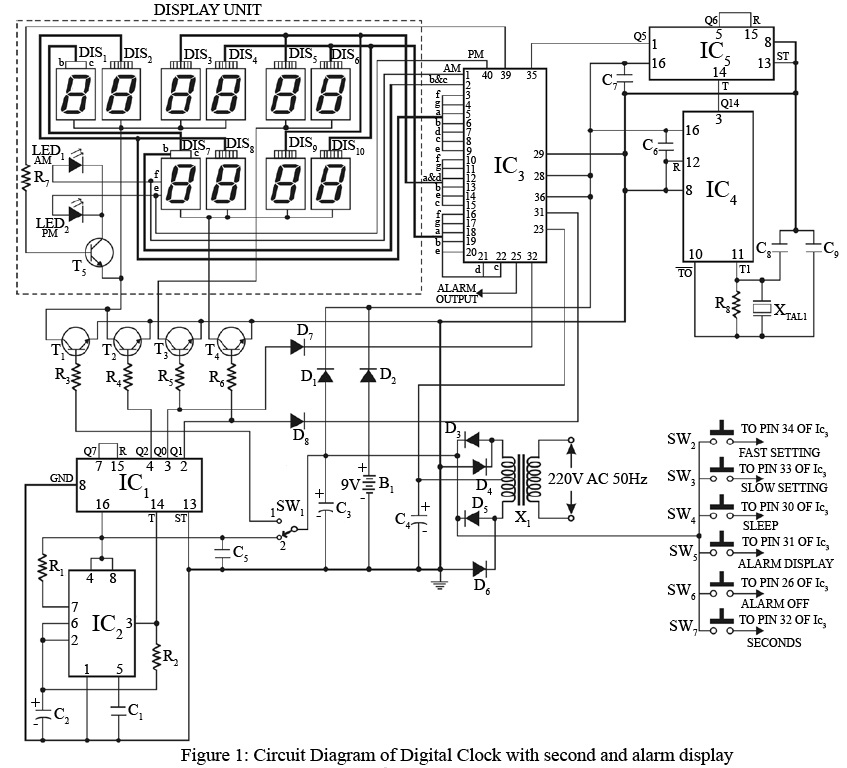

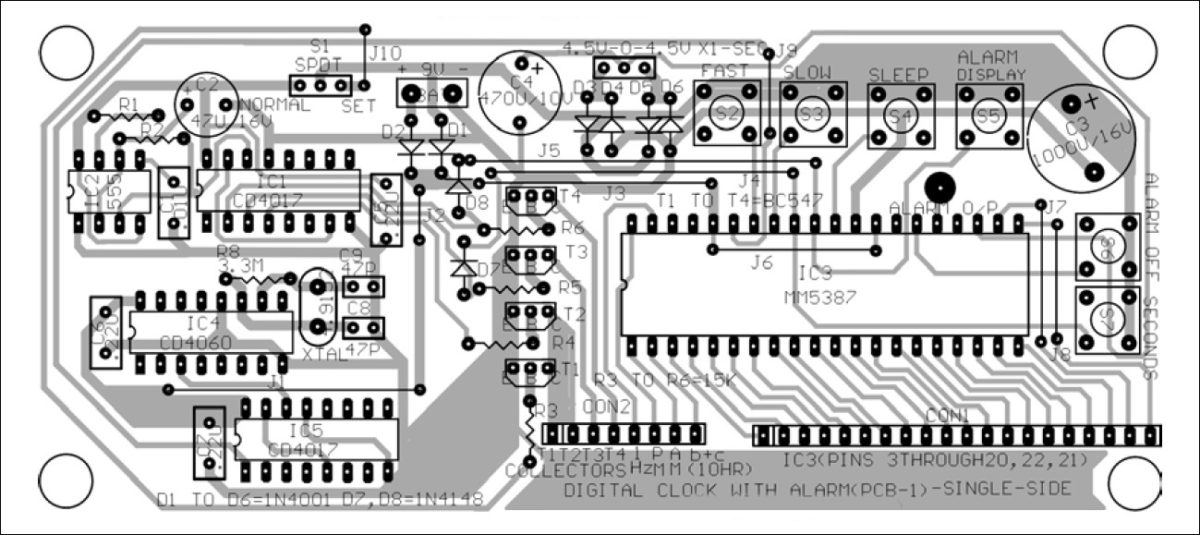
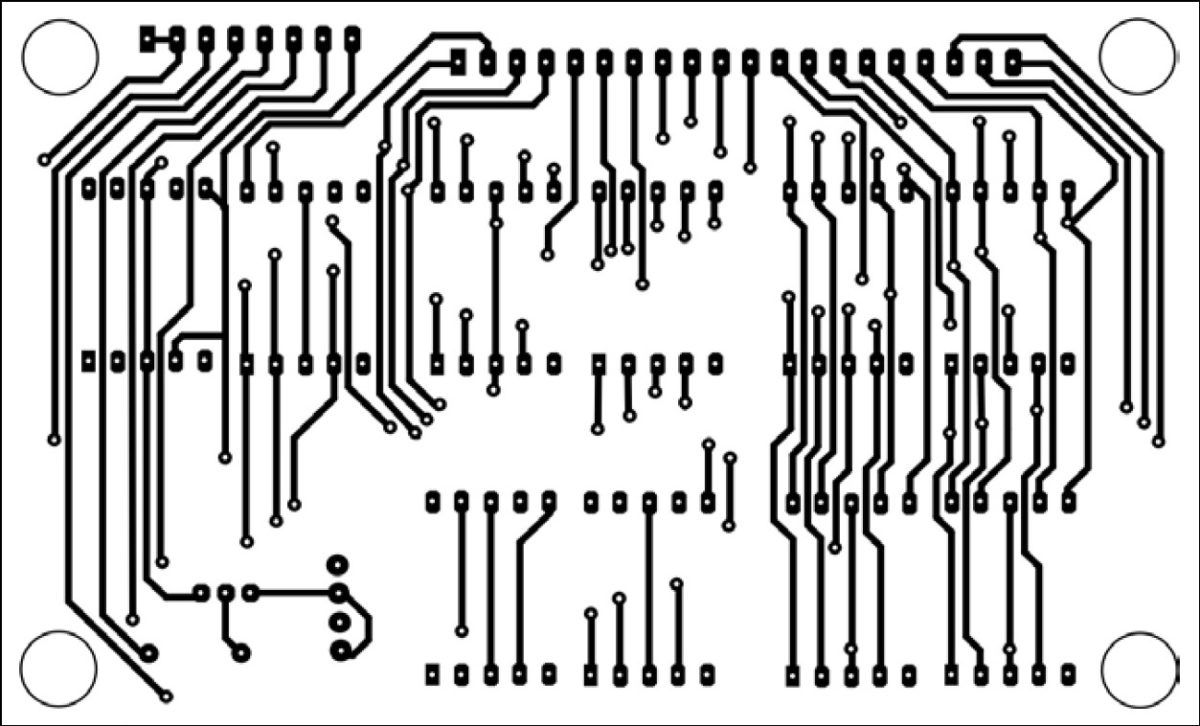
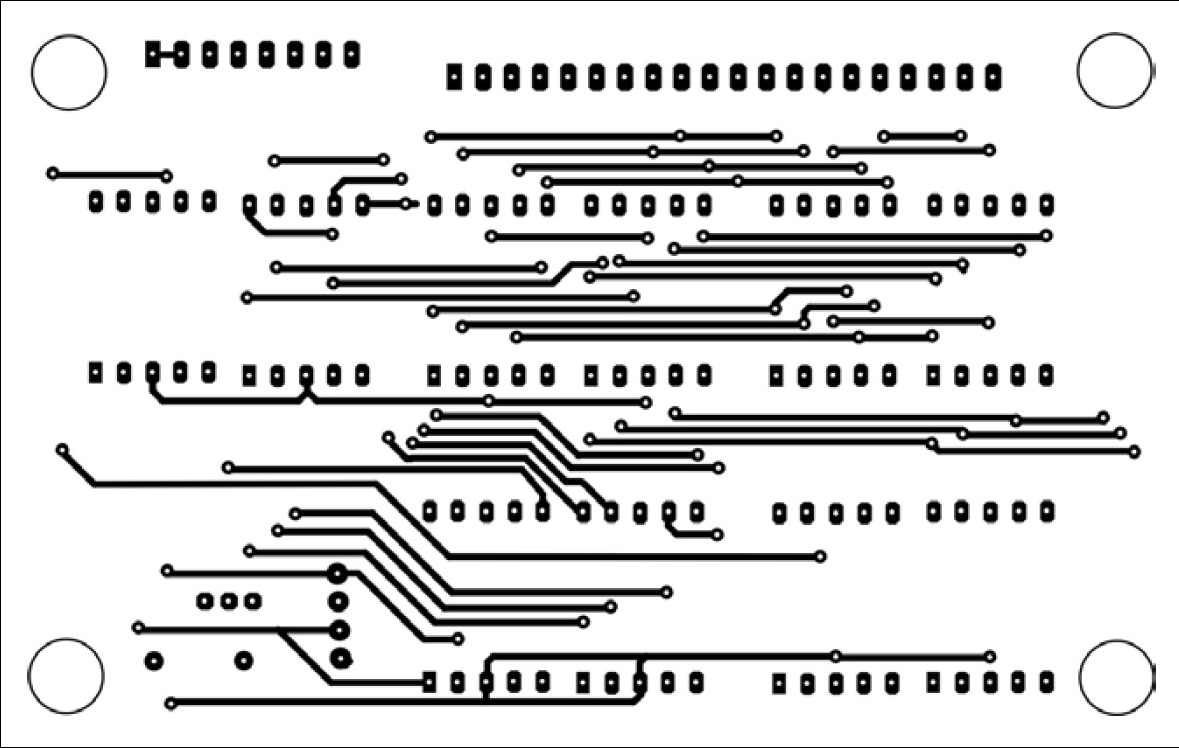
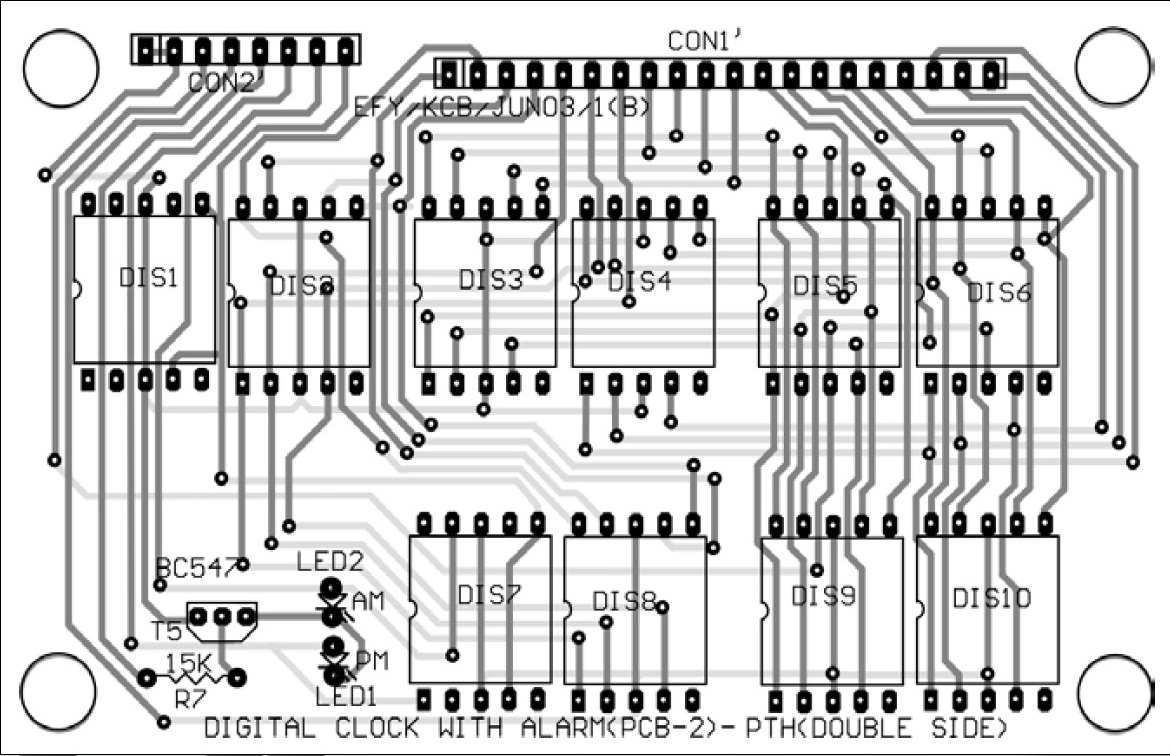
IC5 which divides 300 Hz clock pulse by 6 in order to obtain 50 Hz clock pulse and given to pin 36 of IC3
Not pin 36 …… pin 35
can you please clarify the pins configuration for the common cathode because it is not clear ??
THANK YOU VERY MUCH
Are the PCB’s available to purchase for this project.
Thanks for concern, we had updated the article with PCB design.
Thanks for reply but I was wondering if you had found out if anybody had made the Printed Circuit boards for this project, and offering the set,s for sale.
For for detail please use our contact page.
From where can I purchage components in baroda Gujarat India , pls give me contact no.